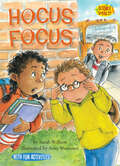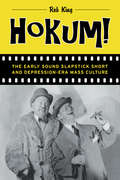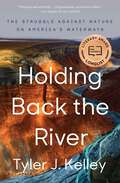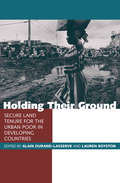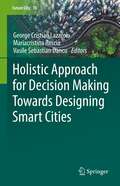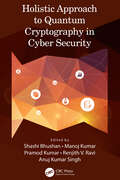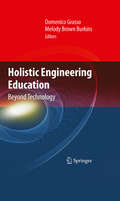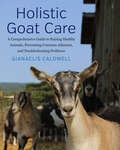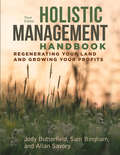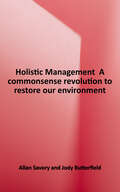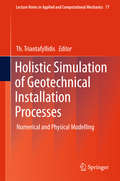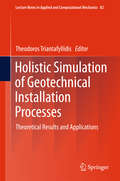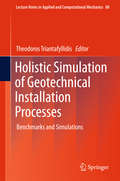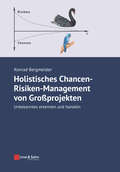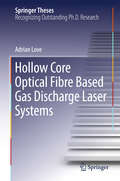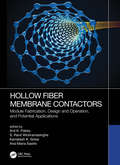- Table View
- List View
Hocus Focus (Science Solves It!)
by Sarah WillsonSolve kid-sized dilemmas and mysteries with the Science Solves It! series. These fun books for kids ages 5–8 blend clever stories with real-life science. Why did the dog turn green? Can you control a hiccup? Is that a UFO? Find the answers to these questions and more as kid characters dive into physical, life, and earth sciences. Jack and Gina are not really thrilled about having to wear glasses. Hank, the class smart aleck, just makes things worse with his teasing. But when a class trip to the rock quarry almost ends in disaster, Jack, Gina, and Hank learn to see things a little more clearly. Books in this perfect STEM series will help kids think like scientists and get ahead in the classroom. Activities and experiments are included in every book! (Level Two; Science topic: Vision)
Hokum!: The Early Sound Slapstick Short and Depression-Era Mass Culture
by Rob KingA free ebook version of this title is available through Luminos, University of California Press’s Open Access publishing program. Visit www.luminosoa.org to learn more. Hokum! is the first book to take a comprehensive view of short-subject slapstick comedy in the early sound era. Challenging the received wisdom that sound destroyed the slapstick tradition, author Rob King explores the slapstick short’s Depression-era development against a backdrop of changes in film industry practice, comedic tastes, and moviegoing culture. Each chapter is grounded in case studies of comedians and comic teams, including the Three Stooges, Laurel and Hardy, and Robert Benchley. The book also examines how the past legacy of silent-era slapstick was subsequently reimagined as part of a nostalgic mythology of Hollywood’s youth.
Hold Zero!
by Jean Craighead GeorgeCraig and his friends have a big secret—they&’ve built a real, working rocket. But will the countdown to takeoff begin before they&’re discovered? Best friends Craig, Steve, Johnny, and Phil have spent months building a rocket—not some model or a toy, but a real rocket, with boosters and a launch pad and a remote control panel. Even better, they&’ve managed to pull off the whole project in secret. The boys can&’t wait to launch their rocket . . . but then their parents find out what they&’ve been up to and tell the police. When they see how sophisticated the rocket really is, the police insist on inspecting all the blueprints and calculations, and the boys find themselves in a lot of trouble. Will their project go up in smoke? This ebook features an illustrated biography of Jean Craighead George, including rare photos from the author&’s personal collection.
Hold Zero!
by Jean Craighead GeorgeCraig and his friends have a big secret—they&’ve built a real, working rocket. But will the countdown to takeoff begin before they&’re discovered? Best friends Craig, Steve, Johnny, and Phil have spent months building a rocket—not some model or a toy, but a real rocket, with boosters and a launch pad and a remote control panel. Even better, they&’ve managed to pull off the whole project in secret. The boys can&’t wait to launch their rocket . . . but then their parents find out what they&’ve been up to and tell the police. When they see how sophisticated the rocket really is, the police insist on inspecting all the blueprints and calculations, and the boys find themselves in a lot of trouble. Will their project go up in smoke? This ebook features an illustrated biography of Jean Craighead George, including rare photos from the author&’s personal collection.
Holding Back the River: The Struggle Against Nature on America's Waterways
by Tyler J. KelleyA revelatory work of reporting on the men and women wrestling to harness and preserve America&’s most vital natural resource: our rivers.The Mississippi. The Missouri. The Ohio. America&’s great rivers are the very lifeblood of our country. We need them for nourishing crops, for cheap bulk transportation, for hydroelectric power, for fresh drinking water. Rivers are also part of our mythology, our collective soul; they are Mark Twain, Led Zeppelin, and the Delta Blues. But as infrastructure across the nation fails and climate change pushes rivers and seas to new heights, we&’ve arrived at a critical moment in our battle to tame these often-destructive forces of nature. Tyler J. Kelley spent two years traveling the heartland, getting to know the men and women whose lives and livelihoods rely on these tenuously tamed streams. The result, Holding Back the River, is a deeply human exploration of how our centuries-long dream of conquering and shaping this vast network of waterways squares with the reality of an indomitable natural world. On the Illinois-Kentucky border, we encounter Luther Helland, master of the most important—and most decrepit—lock and dam in American. This old dam, at the tail end of the Ohio River, was scheduled to be replaced in 1998, but twenty years and $3 billion later, its replacement still isn&’t finished. As the old dam crumbles and commerce grinds to a halt, Helland and his team must risk their lives, using steam-powered equipment and sheer brawn, to raise and lower the dam as often as ten times a year. In Southeast Missouri, we meet Twan Robinson, who lives in the historically Black village of Pinhook. As a super-flood rises on the Mississippi, she learns from her sister that the US Army Corps of Engineers is going to blow up the levee that stands between her home and the river. With barely enough notice to evacuate her elderly mother and pack up a few of her own belongings, Robinson escapes to safety only to begin a nightmarish years-long battle to rebuild her lost community. Atop a floodgate in central Louisiana, we&’re beside Major General Richard Kaiser, the man responsible for keeping North America&’s greatest river under control. Kaiser stands above the spot where the Mississippi River wants to change course, abandoning Baton Rouge and New Orleans, and following the Atchafalaya River to the sea. The daily flow of water from one river to the other is carefully regulated, but something else is happening that may be out of Kaiser and the Corps&’ control. America&’s infrastructure is old and underfunded. While our economy, society, and climate have changed, our levees, locks, and dams have not. Yet to fix what&’s wrong will require more than money. It will require an act of imagination. Meticulously researched and as lively as it is informative, Holding Back the River brings us into the lives of the Americans who grapple with our mighty rivers and, through their stories, suggests solutions to some of the century&’s greatest challenges.
Holding Fast to Dreams
by Freeman A. Hrabowski IIIAn education leader relates how his experiences with the civil rights movement led him to develop programs promoting educational success in science and technology for African Americans and others. When Freeman Hrabowski was twelve years old, a civil rights leader visited his Birmingham, Alabama, church and spoke about a children's march for civil rights and opportunity. That leader was the Reverend Martin Luther King Jr., and that march changed Hrabowski's life. Until then, Freeman was a kid who loved school and solving math problems. Although his family had always stressed the importance of education, he never expected that the world might change and that black and white students would one day study together. But hearing King speak changed everything for Hrabowski, who convinced his parents that he needed to answer King's call to stand up for equality. While participating in the famed Children's Crusade, he spent five terrifying nights in jail--during which Freeman became a leader for the younger kids, as he learned about the risk and sacrifice that it would take to fight for justice. Hrabowski went on to fuse his passion for education and for equality, as he made his life's work inspiring high academic achievement among students of all races in science and engineering. It also brought him from Birmingham to Baltimore, where he has been president of the University of Maryland, Baltimore County for more than two decades. While at UMBC, he co-founded the Meyerhoff Scholars Program, which has been one of the most successful programs for educating African Americans who go on to earn doctorates in the STEM disciplines. In Holding Fast to Dreams, Hrabowski recounts his journey as an educator, a university president, and a pioneer in developing successful, holistic programs for high-achieving students of all races.From the Hardcover edition.
Holding Their Ground: Secure Land Tenure for the Urban Poor in Developing Countries
by Alain Durand-Lasserve Lauren RoystonSecurity of land tenure for the urban poor is now a major problem for developing cities in Africa, Asia and Latin America. This book presents and analyzes the main conclusions of a comparative research programme on land tenure issues. It looks at how solutions can be found and implemented to respond to the demands and needs of the majority of squatters and informal settlements, and analyzes how urban stakeholders, with different social, legal and economic constraints, find innovative and flexible solutions. The book is intended to fill a gap in the literature on comparative research on tenure policies and should be useful to researchers and professionals involved in defining and instigating tenure upgrading policies and programmes.
Holding the Line: Women in the Great Arizona Mine Strike of 1983
by Barbara KingsolverHolding the Line, Barbara Kingsolver's first non-fiction book, is the story of women's lives transformed by an a signal event. Set in the small mining towns of Arizona, it is part oral history and part social criticism, exploring the process of empowerment which occurs when people work together as a community. Like Kingsolver's award-winning novels, Holding the Line is a beautifully written book grounded on the strength of its characters. Hundreds of families held the line in the 1983 strike against Phelps Dodge Copper in Arizona. After more than a year the strikers lost their union certification, but the battle permanently altered the social order in these small, predominantly Hispanic mining towns. At the time the strike began, many women said they couldn't leave the house without their husband's permission. Yet, when injunctions barred union men from picketing, their wives and daughters turned out for the daily picket lines. When the strike dragged on and men left to seek jobs elsewhere, women continued to picket, organize support, and defend their rights even when the towns were occupied by the National Guard. "Nothing can ever be the same as it was before," said Diane McCormick of the Morenci Miners Women's Auxiliary. "Look at us. At the beginning of this strike, we were just a bunch of ladies. "
Holdout: A Novel
by Jeffrey KlugerWhen evil forces are going unchecked on Earth, a principled astronaut makes a spilt-second decision to try to seek justice in the only place she knows how—the International Space Station.Walli Beckwith is a model astronaut. She graduated at the top of her class from the Naval Academy, had a successful career flying fighter jets, and has spent more than three hundred days in space. So when she refuses to leave her post aboard the International Space Station following an accident that forces her fellow astronauts to evacuate, her American and Russian colleagues are mystified. For Walli, the matter at hand feels all too clear and terrifying for her to be worried about ruining her career. She is stuck in a race against time to save a part of the world that seems to have been forgotten, and also the life of the person she loves the most. She will go to any length necessary, using the only tool she has, to accomplish what she knows is right.
Hole Conductor Free Perovskite-based Solar Cells
by Lioz EtgarThis book discusses the promising area of perovskite-based solar cells. It places particular emphasis on a highly unique perovskite solar cell structure, focusing on the special properties of hybrid organic-inorganic perovskites. As such, it offers readers sound essentials, serving as building blocks for the future development of this rapidly evolving field.
Holistic Approach for Decision Making Towards Designing Smart Cities (Future City #18)
by George Cristian Lazaroiu Mariacristina Roscia Vasile Sebastian DancuThis edited volume examines strategies to make future cities more sustainable. The aim of these and other initiatives of the recent past, is to transform our cities into smarter cities. Thereby, these solutions are determined to boost clean electricity and pollution reduction, improve the life of citizens and transform city environment and regulatory structures. As the EUs ambition is to become carbon-neutral until 2050, the outlined projects also consider fostering economy prosperity and social wellness and environmental sustainability. The greatest challenge being already built urban spaces that need to be transformed quickly and at low costs. The book will analyze future smart cities in three centric dimensions: energy and sustainable development, smart infrastructures for smart cities, social involvement and economic prosperity. With its global approach, the volume is highly useful for professionals involved in city planning and urban ecology.
Holistic Approach to Quantum Cryptography in Cyber Security
by Shashi Bhushan, Manoj Kumar, Pramod Kumar, Renjith V. Ravi and Anuj Kumar SinghThis new book discusses the concepts while also highlighting the challenges in the field of quantum cryptography and also covering cryptographic techniques and cyber security techniques, in a single volume. It comprehensively covers important topics in the field of quantum cryptography with applications, including quantum key distribution, position-based quantum cryptography, quantum teleportation, quantum e-commerce, quantum cloning, cyber security techniques’ architectures and design, cyber security techniques management, software-defined networks, and cyber security techniques for 5G communication. The text also discusses the security of practical quantum key distribution systems, applications and algorithms developed for quantum cryptography, as well as cyber security through quantum computing and quantum cryptography. The text will be beneficial for graduate students, academic researchers, and professionals working in the fields of electrical engineering, electronics and communications engineering, computer science, and information technology.
Holistic Design of Resonant DC Transformer on Constant Voltage Conversion, Cascaded Stability and High Efficiency
by Xin Zhang Bin Zhao Hao Ma Fanfan Lin Jingjing HuangThis book is devoted to the optimum design of the DCT in a hybrid AC/DC microgrid, which takes into account not only the influence of different inductors/capacitors values, but also numerous design goals (i.e., VCG, efficiency, stability and so on). This book examines the DCT's design problem in detail. It begins by reviewing existing DCTs in, the hybrid AC/DC microgrid and their design problems. Following that, this book proposes a family of DCT optimization design approaches to ensure that the designed DCT has good power transmission and voltage regulation ability in the hybrid AC/DC microgrid, even when the actual inductors/capacitors values fluctuate with practical power and temperature. Following that, this book provides a family of multi-objective optimization design methodologies for the DCT to guarantee that it concurrently achieves the requirements of VCG, efficiency, and system stability. This book also covers how to control the DCT in a hybrid AC/DC microgrid optimally and generically.
Holistic Engineering Education
by Melody Burkins Domenico GrassoHolistic Engineering Education: Beyond Technology is a compilation of coordinated and focused essays from world leaders in the engineering profession who are dedicated to a transformation of engineering education and practice. The contributors define a new and holistic approach to education and practice that captures the creativity, interdisciplinarity, complexity, and adaptability required for the profession to grow and truly serve global needs. With few exceptions today, engineering students and professionals continue to receive a traditional, technically-based education and training using curriculum models developed for early 20th century manufacturing and machining. While this educational paradigm has served engineering well, helping engineers create awe-inspiring machines and technologies for society, the coursework and expectations of most engineering programs eschew breadth and intellectual exploration to focus on consistent technological precision and study. Why this dichotomy? While engineering will always need precise technological skill, the 21st century innovation economy demands a new professional perspective that recognizes the value of complex systems thinking, cross-disciplinary collaborations, economic and environmental impacts (sustainability), and effective communication to global and community leaders, thus enabling engineers to consider "the whole patient" of society's needs. The goal of this book is to inspire, lead, and guide this critically needed transformation of engineering education. "Holistic Engineering Education: Beyond Technology points the way to a transformation of engineering education and practice that will be sufficiently robust, flexible, and systems-oriented to meet the grand challenges of the 21st century with their ever-increasing scale, complexity, and transdisciplinary nature." -- Charles Vest, President, National Academy of Engineering; President Emeritus, MIT "This collection of essays provides compelling arguments for the need of an engineering education that prepares engineers for the problems of the 21st century. Following the National Academy's report on the Engineer of 2020, this book brings together experts who make the case for an engineering profession that looks beyond developing just cool technologies and more into creating solutions that can address important problems to benefit real people." -- Linda Katehi, Chancellor, University of California at Davis "This superb volume offers a provocative portrait of the exciting future of engineering education...A dramatically new form of engineering education is needed that recognizes this field as a liberal art, as a profession that combines equal parts technical rigor and creative design...The authors challenge the next generation to engineering educators to imagine, think and act in new ways. " -- Lee S. Shulman, President Emeritus, The Carnegie Foundation for the Advancement of Teaching and Charles E. Ducommun Professor of Education Emeritus, Stanford University
Holistic Goat Care: A Comprehensive Guide to Raising Healthy Animals, Preventing Common Ailments, and Troubleshooting Problems
by Gianaclis Caldwell"Practical, well written, and comprehensive. . . . Read this book cover to cover, or keep it handy as a reference for all aspects of goat care."—Sarah Flack, author of The Art and Science of Grazing This one-of-a-kind guide will empower even novice goat owners, offering expert guidance on maintaining a healthy herd—whether they are dairy, meat, fiber, or pet goats Goats have provided humankind with essential products for centuries; indeed, they bear the noble distinction of being the first domesticated farm animal. From providing milk and meat for sustenance and fiber and hides for clothing and shelter to carrying packs and clearing brush, there isn’t much that goats cannot do. Managing goats successfully requires an understanding of how nature designed them to thrive, including nutritional and psychological needs, as well as how to identify a problem and intercede before it’s too late. For more than a decade, Gianaclis Caldwell and her family have operated Pholia Farm Creamery, an off-grid, raw milk goat cheese dairy. In Holistic Goat Care, Caldwell offers readers a comprehensive guide to maintaining a healthy herd of goats, whether they are dairy goats, meat goats, fiber goats, or pet goats. Holistic Goat Care will empower even novice goat owners to confidently diagnose and treat most of the ailments that goats might experience. For the experienced goat farmer, the book offers a depth of insight and approaches to treatment not found in any other book. Caldwell places special emphasis throughout on holistic, natural, and alternative approaches to caring for goats, including information on: Handling and managing goats using their natural instincts as an asset Developing good farm management practices such as appropriate housing and fencing systems and manure and mortality management Making feeding decisions based on understanding goats’ ruminant digestive system and their evolutionary needs Growing forage and garden crops as feed and utilizing wild browse Troubleshooting health problems based on assessing symptoms Implementing advanced health procedures such as pain control, fecal testing, and transplanting rumen microbes from healthy to sick goats Diagnosing, treating, and preventing more than 75 common goat ailments Whether your herd is two or two hundred, this first-of-its-kind, comprehensive book will help you keep your goats healthy, safe, and productive and give you a deep and enjoyable insight into the wondrous creature that is the goat.
Holistic Management Handbook, Third Edition: Regenerating Your Land and Growing Your Profits
by Jody Butterfield Allan Savory Sam BinghamHolistic management is a systems-thinking approach developed by biologist Allan Savory to restore the world's grassland soils and minimize the damaging effects of climate change and desertification on humans and the natural world. This third edition of Holistic Management Handbook: Regenerating Your Land and Growing Your Profits is the long-awaited companion volume to the classic text Holistic Management, Third Edition. Crafted under the direction of Savory's longtime collaborator Jody Butterfield, this handbook is the key to developing a comprehensive holistic land plan based on Savory's principles that will help you to restore health to your land and ensure a stable, sustainable livelihood from its bounty.This new edition, thoroughly revised, updated, and streamlined, explains the planning procedures described in Holistic Management, and offers step-by-step instructions for running a ranch or farm using a holistic management approach. Butterfield and her coauthors describe how to use the handbook in conjunction with the textbook to tailor a management plan for your unique combination of land, livestock, and finances. Their mantra is "plan, monitor, control, and replan.” Using a four-part approach, the authors walk readers through basic concepts and techniques, help them put a plan onto paper, monitor the results, and adjust the details as needed. Appendixes provide updated worksheets, checklists, planning and monitoring forms, and detailed examples of typical scenarios a user might encounter. The handbook includes a comprehensive glossary of terms.Ranchers, farmers, pastoralists, social entrepreneurs, government agencies, and NGOs working to address global environmental degradation will find this comprehensive handbook an indispensable guide to putting the holistic management concept into action with tangible results they can take to the bank.
Holistic Management, Third Edition: A Commonsense Revolution to Restore Our Environment
by Allan SavoryFossil fuels and livestock grazing are often targeted as major culprits behind climate change and desertification. But Allan Savory, cofounder of the Savory Institute, begs to differ. The bigger problem, he warns, is our mismanagement of resources. Livestock grazing is not the problem; it's how we graze livestock. If we don't change the way we approach land management, irreparable harm from climate change could continue long after we replace fossil fuels with environmentally benign energy sources. Holistic management is a systems-thinking approach for managing resources developed by Savory decades ago after observing the devastation of desertification in his native Southern Rhodesia (now Zimbabwe). Properly managed livestock are key to restoring the world's grassland soils, the major sink for atmospheric carbon, and minimizing the most damaging impacts on humans and the natural world. This book updates Savory's paradigm-changing vision for reversing desertification, stemming the loss of biodiversity, and eliminating fundamental causes of human impoverishment throughout the world, and climate change. Reorganized chapters make it easier for readers to understand the framework for Holistic Management and the four key insights that underlie it. New color photographs showcase before-and-after examples of land restored by livestock. This long-anticipated new edition is written for new generations of ranchers, farmers, eco- and social entrepreneurs, and development professionals working to address global environmental and social degradation. It offers new hope that a sustainable future for humankind and the world we depend on is within reach.
Holistic Simulation of Geotechnical Installation Processes
by Th. TriantafyllidisThe book provides suitable methods for the simulations of boundary value problems of geotechnical installation processes with reliable prediction for the deformation behavior of structures in static or dynamic interaction with the soil. It summarizes the basic research of a research group from scientists dealing with constitutive relations of soils and their implementations as well as contact element formulations in FE-codes. Numerical and physical experiments are presented providing benchmarks for future developments in this field. Boundary value problems have been formulated and solved with the developed tools in order to show the effectivity of the methods. Parametric studies of geotechnical installation processes in order to identify the governing parameters for the optimization of the process are given in such a way that the findings can be recommended to practice for further use. For many design engineers in practice the assessment of the serviceability of nearby structures due to geotechnical installation processes is a very challenging task. Some hints about possible effects and their consideration are given in this book which may provide a help for such estimations which are still not possible to be given in a satisfactory manner.
Holistic Simulation of Geotechnical Installation Processes
by Theodoros TriantafyllidisThis book examines in detail the entire process involved in implementing geotechnical projects, from a well-defined initial stress and deformation state, to the completion of the installation process. The individual chapters provide the fundamental knowledge needed to effectively improve soil-structure interaction models. Further, they present the results of theoretical fundamental research on suitable constitutive models, contact formulations, and efficient numerical implementations and algorithms. Applications of fundamental research on boundary value problems are also considered in order to improve the implementation of the theoretical models developed. Subsequent chapters highlight parametric studies of the respective geotechnical installation process, as well as elementary and large-scale model tests under well-defined conditions, in order to identify the most essential parameters for optimizing the process. The book provides suitable methods for simulating boundary value problems in connection with geotechnical installation processes, offering reliable predictions for the deformation behavior of structures in static contexts or dynamic interaction with the soil.
Holistic Simulation of Geotechnical Installation Processes
by Theodoros TriantafyllidisThis book examines in detail the entire process involved in implementing geotechnical projects, from a well-defined initial stress and deformation state, to the completion of the installation process. The individual chapters provide the fundamental knowledge needed to effectively improve soil-structure interaction models. Further, they present the results of theoretical fundamental research on suitable constitutive models, contact formulations, and efficient numerical implementations and algorithms. Applications of fundamental research on boundary value problems are also considered in order to improve the implementation of the theoretical models developed. Subsequent chapters highlight parametric studies of the respective geotechnical installation process, as well as elementary and large-scale model tests under well-defined conditions, in order to identify the most essential parameters for optimizing the process. The book provides suitable methods for simulating boundary value problems in connection with geotechnical installation processes, offering reliable predictions for the deformation behavior of structures in static contexts or dynamic interaction with the soil.
Holistisches Chancen-Risiken-Management von Grossprojekten: Unbekanntes erkennen und handeln
by Konrad BergmeisterExtreme Ereignisse sind in unserem Denken meist weit weg entfernt. Treten sie trotzdem ein, treffen sie uns oft unerwartet. Wenn Ereignisse mit schweren Folgen für die Umwelt und den Menschen einzeln auftreten, werden sie von den meisten Menschen als extrem empfunden. Eine Vielzahl von kleineren Ereignissen über einen längeren Zeitraum, deren Wirkung in Summe ähnlich groß ist, kümmern hingegen kaum jemanden. Gerade bei großen Bauprojekten verursacht das Eintreten von nicht erwarteten, extremen Ereignissen wie Naturgefahren, der Einsturz einer Brücke oder der Brand in einem Tunnel oft eine auch öffentlich wahrgenommene Schockwirkung. Aber auch die Überschreitung von Kosten und Bauzeiten, bedingt durch unbekannte Risiken, verursachen Ängste und Schuldzuweisungen.Das Buch zeigt einen möglichen Weg auf, wie solchen unbekannten Risiken aber auch Chancen begegnet werden kann. Basierend auf wissenschaftlichen Grundlagen und umfangreichen prak-tischen Erfahrungen wird ein strukturiertes holistisches Chancen-Risiken-Management für Großprojekte erläutert. Auch auf die Corona-Thematik wird aus Sicht des Chancen-Risiken- Managements eingegangen.
Hollow Core Optical Fibre Based Gas Discharge Laser Systems (Springer Theses)
by Adrian LoveThe research in this book represents the culmination of a drive to build the first discharge gas laser unencumbered by the effects of diffraction. This breakthrough has been achieved through careful implementation of a discharge within a hollow-core optical fibre, and by developing measurement and analysis techniques to demonstrate laser action in an experimental optical cavity. Gas lasers were amongst the earliest laser types to be demonstrated and commercialised, but it was recognised that noble gas lasers were limited by the minimum bore diameter of the laser tube, which is set by diffraction. The advent, in 2011, of hollow optical fibres with optical and physical properties suitable for gas discharge lasers opened up the opportunity to break this diffraction limit. Using a mixture of helium and xenon gas, lasing in the mid-infrared range was achieved using a 100µm core flexible hollow optical fibre which, at 1m long, is several hundred times the diffraction-limited Rayleigh length.
Hollow Fiber Membrane Contactors: Module Fabrication, Design and Operation, and Potential Applications
by Anil K. Pabby, S. Ranil Wickramasinghe, Kamalesh K. Sirkar, Ana-Maria SastreThis book on hollow fiber contractors presents an up-to-date compilation of the latest developments and milestones in this membrane technology. Hollow Fiber Membrane Contactors: Module Fabrication, Design and Operation, and Potential Applications provides a comprehensive discussion of hollow fiber membrane applications (including a few case studies) in biotechnology, chemical, food, and nuclear engineering. The chapters in this book have been classified using the following, based on different ways of contacting fluids with each other: Gas-liquid contacting; Liquid-liquid contacting; Supported liquid membrane; Supported gas membrane; Fluid-fluid contacting. Other features include: Discusses using non-dispersive solvent extraction, hollow fiber strip dispersion, hollow fiber supported liquid membranes and role of process intensification in integrated use of these processes Provides technical and economic perspectives with several case studies related to specific scenarios Demonstrates module fabrication, design, operation and maintenance of hollow fiber contactors for different applications and performance Presents discussion on newer concepts like membrane emulsification, membrane nanoprecipitation, membrane crystallization and membrane condenser Special focus on emerging areas such as the use of hollow fiber contactor in back end of nuclear fuel cycle, membrane distillation, dehumidification of air and gas absorption and stripping Discusses theoretical analysis including computational modeling of different hollow fiber membrane processes, and presents emphasis on newly developed area of hollow fiber membrane based analytical techniques Presents discussion on upcoming area dealing with hollow fiber contactors-based technology in fermentation and enzymatic transformation and in chiral separations This book is equally suited for newcomers to the field, as well as for engineers and scientists that have basic knowledge in this field but are interested in obtaining more information about specific future applications.
Hollowgirl (Twinmaker #3)
by Sean WilliamsThe mind-bending conclusion to the Twinmaker series, perfect for fans of the Uglies series, from #1 New York Times bestselling author Sean Williams. Clair's world has been destroyed—again. The only remaining hope of saving her friends is for her and Q to enter the Yard, the digital world of Ant Wallace's creation. The rules there are the same as those of the real world: Water is real; fire is real; death is real. But in the Yard there are two Clair Hills, and their very existence causes cracks that steadily widen.Getting inside is the easy part. Once there, she has to earn the trust of her friends, including the girl who started it all—her best friend, Libby. Together they must fight their way through the digital and political minefield in the hope of saving the world once and for all. And this time Clair has to get it right . . . or lose everything.
Hollywood Lighting from the Silent Era to Film Noir (Film and Culture Series)
by Patrick KeatingLighting performs essential functions in Hollywood films, enhancing the glamour, clarifying the action, and intensifying the mood. Examining every facet of this understated art form, from the glowing backlights of the silent period to the shaded alleys of film noir, Patrick Keating affirms the role of Hollywood lighting as a distinct, compositional force.Closely analyzing Girl Shy (1924), Anna Karenina (1935), Only Angels Have Wings (1939), and T-Men (1947), along with other brilliant classics, Keating describes the unique problems posed by these films and the innovative ways cinematographers handled the challenge. Once dismissed as crank-turning laborers, these early cinematographers became skillful professional artists by carefully balancing the competing demands of story, studio, and star. Enhanced by more than one hundred illustrations, this volume counters the notion that style took a backseat to storytelling in Hollywood film, proving that the lighting practices of the studio era were anything but neutral, uniform, and invisible. Cinematographers were masters of multifunctionality and negotiation, honing their craft to achieve not only realistic fantasy but also pictorial artistry.
